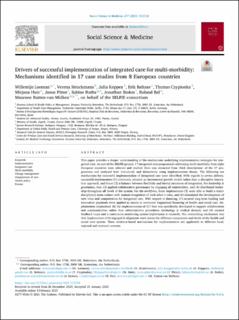| dc.contributor.author | Looman, Willemijn | |
| dc.contributor.author | Struckmann, Verena | |
| dc.contributor.author | Koppen, Julia | |
| dc.contributor.author | Baltaxe, Erik | |
| dc.contributor.author | Czypionka, Thomas | |
| dc.contributor.author | Huic, Mirjana | |
| dc.contributor.author | Pitter, Janos | |
| dc.contributor.author | Ruths, Sabine | |
| dc.contributor.author | Stokes, Jonathan | |
| dc.contributor.author | Bal, Roland | |
| dc.contributor.author | Rutten-van Molken, maureen | |
| dc.date.accessioned | 2021-05-20T09:26:33Z | |
| dc.date.available | 2021-05-20T09:26:33Z | |
| dc.date.created | 2021-05-15T15:54:57Z | |
| dc.date.issued | 2021 | |
| dc.identifier.issn | 0277-9536 | |
| dc.identifier.uri | https://hdl.handle.net/11250/2755814 | |
| dc.description.abstract | This paper provides a deeper understanding of the mechanisms underlying implementation strategies for integrated care. As part of the SELFIE project, 17 integrated care programmes addressing multi-morbidity from eight European countries were selected and studied. Data was extracted from ‘thick descriptions’ of the 17 programmes and analysed both inductively and deductively using implementation theory. The following ten mechanisms for successful implementation of integrated care were identified. With regards to service delivery, successful implementers (1) commonly adopted an incremental growth model rather than a disruptive innovation approach, and found (2) a balance between flexibility and formal structures of integration. For leadership & governance, they (3) applied collaborative governance by engaging all stakeholders, and (4) distributed leadership throughout all levels of the system. For the workforce, these implementers (5) were able to build a multidisciplinary team culture with mutual recognition of each other’s roles, and (6) stimulated the development of new roles and competencies for integrated care. With respect to financing, (7) secured long-term funding and innovative payments were applied as means to overcome fragmented financing of health and social care. Implementers emphasised (8) the implementation of ICT that was specifically developed to support collaboration and communication rather than administrative procedures (technology & medical devices), and (9) created feedback loops and a continuous monitoring system (information & research). The overarching mechanism was that implementers (10) engaged in alignment work across the different components and levels of the health and social care system. These evidence-based mechanisms for implementation are applicable in different local, regional and national contexts. | |
| dc.language.iso | eng | en_US |
| dc.rights | Navngivelse 4.0 Internasjonal | * |
| dc.rights.uri | http://creativecommons.org/licenses/by/4.0/deed.no | * |
| dc.title | Drivers of successful implementation of integrated care for multi-morbidity: Mechanisms identified in 17 case studies from 8 European countries | en_US |
| dc.type | Peer reviewed | en_US |
| dc.type | Journal article | en_US |
| dc.rights.holder | © 2021, Authors | |
| dc.description.version | publishedVersion | |
| cristin.ispublished | true | |
| cristin.fulltext | original | |
| cristin.qualitycode | 2 | |
| dc.identifier.doi | 10.1016/j.socscimed.2021.113728 | |
| dc.identifier.cristin | 1910172 | |
| dc.source.journal | Social Science and Medicine | en_US |
| dc.relation.project | EC/H2020/634288 | |

